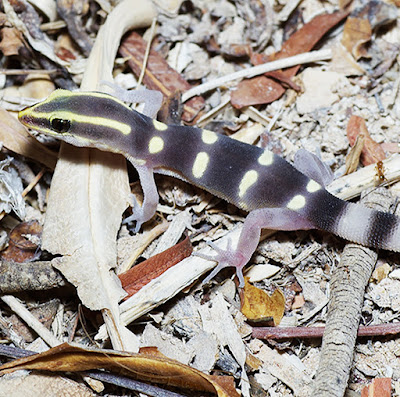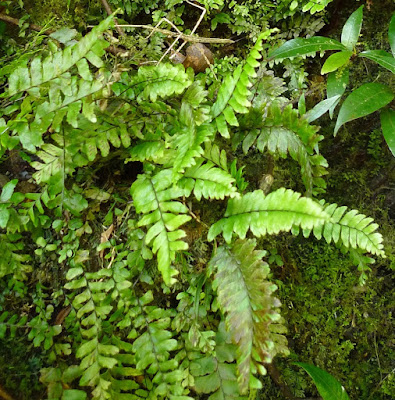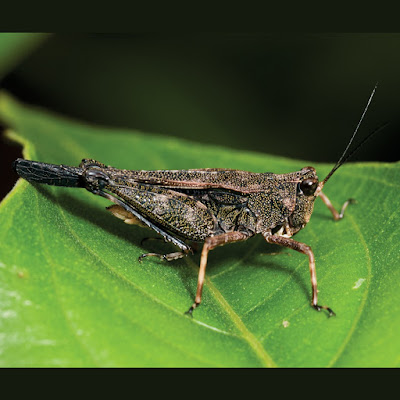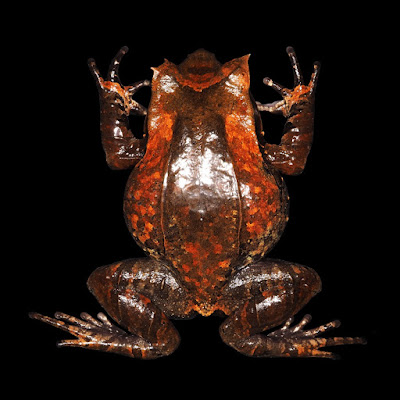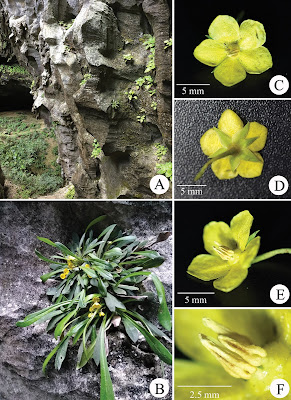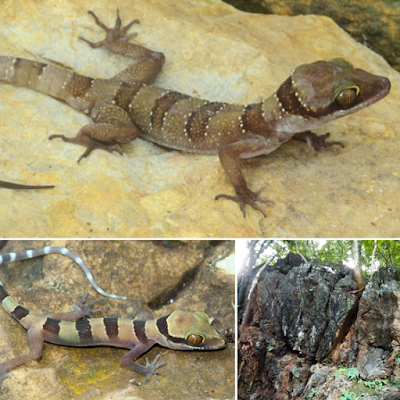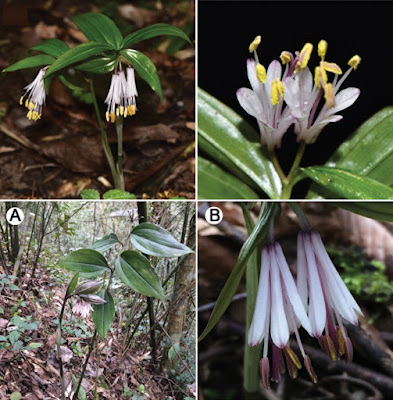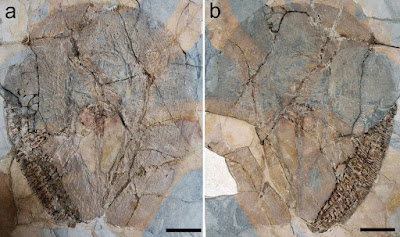[Most Recent Entries] [Calendar View]
Tuesday, October 1st, 2019
| Time | Event | ||||||
| 8:43a | [Herpetology • 2019] Phylogenetic Differentiation and Taxonomic Consequences in the Saurodactylus brosseti species complex (Squamata: Sphaerodactylidae), with Description of Four New Species
Abstract We divide Saurodactylus brosseti into five species, based on molecular and morphological characteristics. Phylogenetic analysis of two mitochondrial markers (ND4 and 12S rRNA) reveals five separately evolving lineages (clades) in the S. brosseti species complex. Each can be assigned to a particular geographical range within the distribution area in Morocco: North, South, Anti-Atlas, East and Southeast. A dichotomous key for all species within the genus Saurodactylus is presented. Despite the high level of color pattern variation among and within the northern, southern, Anti-Atlas and eastern clades, the southeastern lineage shows a unique coloration which is not found in other clades. The ecological traits of the southeastern clade seem to differ from those of the other four lineages since it is basically associated with Acacia species. Like the relictual ecosystem characterized by these trees, it appears to be highly threatened by extinction. Keywords: Reptilia, Saurodactylus splendidus sp. nov., S. harrisii sp. nov., S. slimanii sp. nov., S. elmoudenii sp. nov., phylogeny, species complex, taxonomy Saurodactylus splendidus Soheila Javanmardi, Sven Vogler and Ulrich Joger. 2019. Phylogenetic Differentiation and Taxonomic Consequences in the Saurodactylus brosseti species complex (Squamata: Sphaerodactylidae), with Description of Four New Species. Zootaxa. 4674(4); 401–425. DOI: 10.11646/zootaxa.4674.4.1 | ||||||
| 9:06a | [Botany • 2019] A Revision of the Hymenasplenium unilaterale subclade (Aspleniaceae; Pteridophyta) with the Description of Nine New Species
Abstract A taxonomic study of the Hymenasplenium unilaterale subclade (Aspleniaceae) is presented based on morphological and molecular evidence. Twelve species are recognized, nine of which are described as new. The nine new species include H. kinabaluense, H. solomonense, H. madagascariense, H. nigricostatum, H. neocaledonicum, H. oligosorum, H. queenslandicum, H. samoaense, and H. vanuatuense. Of the 12 species recognized, one occurs in Malaysia, East Africa, and Reunion, one in southern Vietnam, and the rest restricted to 1–2 islands of the Indian Ocean or the Pacific Ocean. These new species have been erroneously treated as H. unilaterale by earlier pteridologists. All species were included in a recent phylogenetic analysis and supported as distinct lineages based on molecular data. A key to the species and information on their distributions, habitats, and major distinguishing characters are provided. Keywords: Cryptic speciation, Indian Ocean islands, Pacific islands, Pteridophytes Ke-Wang Xu, David Lorence, Kenneth R. Wood, Wen-Bo Liao and Li-Bing Zhang. 2019. A Revision of the Hymenasplenium unilaterale subclade (Aspleniaceae; Pteridophyta) with the Description of Nine New Species. Phytotaxa. 419(1); 1–27. DOI: 10.11646/phytotaxa.419.1.1 | ||||||
| 9:13a | [Entomology • 2019] Systematics and Biogeography of the Genus Scaria Bolívar, 1887 (Orthoptera: Tetrigidae: Batrachideinae)
Abstract The Amazon rainforest is the world’s most extensive tropical rainforest, holding a considerable ecological and taxonomic diversity. Speciation in this region arises from multiple factors, such as topography, climate fluctuations, oceanic transgression, vegetation and the delimitation of zones circumscribed by sub-basins within the greater Amazon basin. Different scenarios have been proposed to better understand the diversification of Amazonian taxa, whether by Pleistocene refugia or by areas of endemism. The genus Scaria is distributed mostly in Amazonia, with a single species that ranges from the Tumbes-Chocó-Magdalena ecoregion well into Central America all the way to southern Nicaragua. Eight species are currently recognized, with three additional described here as new: Scaria rafaeli sp. nov., S. jonasi sp. nov. and S. granti sp. nov., and the status of S. laeta stat. resurr. is revalidated. Two new combinations are established: S. verutum comb. nov. (formerly placed in Rehnidium Grant, 1956) and Batrachidea brevis comb. nov. (formerly placed in Scaria). New synonym is proposed: Batrachidea brevis (Hancock, 1909) = Batrachidea inermis Hebard, 1923 syn. nov. Lectotypes and paralectotypes were selected for S. laeta, S. maculata and S. lineata, as well as the neotypes for S. hamata and S. boliviana. An updated key to species of Scaria is also provided. A cladistic analysis for 15 species was performed (12 in the inner group and 3 in the outer group) with 40 morphological characters, confirming the monophyly of Scaria. A biogeographical analysis of dispersion-vicariance indicates that the origin of the genus was probably in the Inambari endemism center as the only reconstruction of the resulting ancestral distribution, five dispersions and three vicariance events being postulated. These suggest that both types of events are equally important in the current configuration of the distribution in Scaria. Vicariance events arise mostly by isolation of the species because of the uplift of the Andes and the dispersion events comprise four waves originating from the ancestral range into central and east Amazonia. Keywords: Orthoptera, Amazon, Andes, Biogeographic Chocó, Neotropics, vicariance, dispersión, Batrachidea, Rehnidium, taxonomy, new taxa, new synonym Batrachidea brevis (Hancock, 1909) Oscar J. Cadena-Castañeda, Diego Matheus De Mello Mendes, Daniela Santos Martins Silva, Juan Manuel Cardona Granda, Alexander García García and Josef Tumbrinck. 2019. Systematics and Biogeography of the Genus Scaria Bolívar, 1887 (Orthoptera: Tetrigidae: Batrachideinae). Zootaxa. 4675(1); 1-65. DOI: 10.11646/zootaxa.4675.1.1 | ||||||
| 10:01a | [Herpetology • 2019] Megophrys kalimantanensis • A New Species of Megophrys Kuhl & Van Hasselt (Amphibia: Megophryidae) from Borneo allied to M. nasuta (Schlegel, 1858)
Abstract Within Sundaland, the species diversity of the genus Megophrys is richest in Borneo, with some species restricted to the northern highlands of the island. On the basis of molecular, morphological and acoustic evidence, we describe a new species of large-sized Megophrys, once confused with M. nasuta. The new species Megophrys kalimantanensis sp. nov. can be differentiated from all its congeners by large genetic distance more than 6.11% in the mitochondrial 16S rRNA gene, much shorter rostral and orbital appendages, and unique advertisement call. This new species has been recorded from medium to high altitudes of mountain forest in southern and northernmost Borneo. Keywords: Amphibia, Megophrys kalimantanensis sp. nov., molecular phylogeny, new species, taxonomy, Southeast Asia Megophrys kalimantanensis sp. nov. Misbahul Munir, Amir Hamidy, Masafumi Matsui, Djoko T. Iskandar, Irvan Sidik and Tomohiko Shimada. 2019. A New Species of Megophrys Kuhl & Van Hasselt (Amphibia: Megophryidae) from Borneo allied to M. nasuta (Schlegel, 1858). Zootaxa. 4679(1); 1–24. DOI: 10.11646/zootaxa.4679.1.1 | ||||||
| 1:30p | [Botany • 2019] Lysimachia fanii • A New Species of Primulaceae from Limestone Area of Guangxi, China
Abstract Lysimachia fanii, a new species of Lysimachia (Subgen. Idiophyton, Primulaceae), is described and illustrated from Guangxi, China based on morphological and molecular data. Lysimachia fanii differs from L. verbascifolia, L. rupestris and L. alpestris mainly by the habit being nearly rosulate, leaves congested at the apex of the rhizome, leaf blades spatulate to narrowly oblanceolate and flowers solitary. Phylogenetic analyses supported L. verbascifolia as sister to L. fanii. This new species is endemic to limestone areas in Liucheng county of Guangxi, China. Keywords: Lysimachia, subgen. Idiophyton, Primulaceae, taxonomy, limestone flora
Lysimachia fanii Y.Feng Huang, W.B.Xu & L.N.Dong, sp. nov. Diagnosis: Lysimachia fanii differs from congeneric species in subgen. Idiophyton mainly by the habit being nearly rosulate, leaves congested at the apex of the rhizome, leaf blades spatulate to narrowly oblanceolate and flowers being solitary. Etymology: The new species is named after Mr. Li-Yong Fan, who first discovered and collected this rare species. Distribution and habitat: Lysimachia fanii is known only from the type locality in Taiping Town, Liucheng County, Guangxi Zhuangzu Autonomous Region, China (Fig. 4). It grows on moist limestone rock surfaces at the entrance to caves. Yun-Feng Huang, Li-Na Dong and Wei‑Bin Xu. 2019. Lysimachia fanii, A New Species of Primulaceae from Limestone Area of Guangxi, China. In: Jie Cai, Wen-Bin Yu, Ting Zhang, De-Zhu Li (Eds) Revealing of the Plant Diversity in China’s Biodiversity Hotspots. PhytoKeys. 130: 75-84. DOI: 10.3897/phytokeys.130.34655 | ||||||
| 2:11p | [Herpetology • 2019] Cyrtodactylus dayangbuntingensis • A New Species of Bent-toed Gecko of the Cyrtodactylus pulchellus complex (Squamata: Gekkonidae) from the Langkawi Archipelago, Peninsular Malaysia
Abstract A new species of limestone karst-adapted gecko of the Cyrtodactylus pulchellus complex, Cyrtodactylus dayangbuntingensis sp. nov., is described from Dayang Bunting Island of the Langkawi Archipelago off the northwest coast of Peninsular Malaysia. It is the third species of the group to be described from the archipelago after C. langkawiensis and C. macrotuberculatus. The new species can be distinguished from all other species of Cyrtodactylus based on molecular evidence from the mitochondrial gene ND2 and its flanking tRNAs as well as having unique combinations of morphological and color pattern characteristics. This discovery underscores the need for continued surveys of the many islands in the archipelago to properly ascertain its true herpetological diversity. Keywords: Reptilia, Integrative taxonomy, phylogeny, molecular systematics, karst, island, conservation Cyrtodactylus dayangbuntingensis sp. nov. Suggested common name: Dayang Bunting Island Bent-toed Gecko Etymology. The specific epithet dayangbuntingensis is in reference to the type locality of this species on Dayang Bunting Island of the Langkawi Archipelago, Kedah, Peninsular Malaysia. Natural history. Cyrtodactylus dayangbuntingensis sp. nov. is a karst-associated species that is only found in close proximity of karst outcrops (Fig. 7B). The holotype (LUSHC 14353) was found under a karst overhang at night approximately 1 m above the ground while the male paratype (LSUHC 14354) was found approximately 1.5 m above the ground on the trunk of a tree that was growing next to and in contact with a karst wall. The female paratype (LSUHC 14355) was found on the ground under a karst overhang. Another adult specimen was observed hiding in a narrow vertical karst crevice 2 m above the ground. A juvenile ( Fig. 7A) was photographed on 17 October 2015 and indicates breeding may take place during the latter half of the year. Other species of geckos observed on the karst were Cnemaspis sp. and Gehyra mutilata (ESHQ per. obs.). Evan S. H. Quah, L. Lee Grismer, Perry L. Wood, Jr. and Shahrul Anuar Mohd Sah. 2019. The Discovery and Description of A New Species of Bent-toed Gecko of the Cyrtodactylus pulchellus complex (Squamata: Gekkonidae) from the Langkawi Archipelago, Kedah, Peninsular Malaysia. Zootaxa. 4668(1); 51–75. DOI: 10.11646/zootaxa.4668.1.3 | ||||||
| 2:33p | [Botany • 2019] Disporum nanchuanense (Colchicaceae) • A New Species from Chongqing, China
Abstract Disporum nanchuanense (Colchicaceae), a new species from Jinfo Mountain National Nature Reserve, Nanchuan District, Chongqing, China, is described and illustrated. It is similar to D. longistylum and D. megalanthum, but differs from the former in its stem branched type, tepals colour and size, stamens and pistil size; and it differs from the latter in inflorescence position, tepals shape, stamens position, pistil position and size. Meanwhile, the new taxon is assessed as Vulnerable (VU D2), according to the IUCN Red List criteria. Furthermore, an identification key to all Chinese species of Disporum is provided. Keywords: Jinfo Mountain, Liliaceae, morphology, taxonomy
Disporum nanchuanense X.X.Zhu & S.R.Yi, sp. nov. Diagnosis: Disporum nanchuanense X.X.Zhu & S.R.Yi is similar to D. longistylum (Léveillé & Vaniot) Hara and D. megalanthum Wang & Tang, but it differs from D. longistylum in its stem which is usually simple, rarely branched, tepals white with purple, apex obtuse, 22–25 × 2.8–4 mm, filaments 20–24 mm long, anthers 5.2–5.6 mm long and ovary ca. 4.6 mm long, style 27–29 mm long; and it differs from D. megalanthum in its inflorescences terminal, petiole 3–13 mm long, tepals white with purple, oblanceolate, apex obtuse, stamens distinctly exserted and ovary ca. 4.6 mm long, style 27–29 mm long, distinctly exserted. Detailed morphological comparison is shown in Table 1 and Figure 4. Etymology: The specific epithet refers to the type locality, Nanchuan District, Chongqing, China. The Chinese name is given as “南川万寿竹”. Distribution and habitat: Disporum nanchuanense is presently known only from the type locality in Jinfo Mountain National Nature Reserve, Nanchuan District, Chongqing. It grows under conifer-broadleaved forest at 1386–1411 m, together with Arisaema bockii Engl. (Araceae), Cardamine hygrophila T.Y.Cheo & R.C.Fang (Brassicaceae), Cephalotaxus fortunei Hook. (Cephalotaxaceae), Liriodendron chinense (Hemsl.) Sargent. (Magnoliaceae), Pinus massoniana Lamb. (Pinaceae), Rhododendron coeloneurum Diels (Ericaceae), Sanicula orthacantha S.Moore (Apiaceae) etc. Xinxin Zhu, Shuai Liao and Sirong Yi. 2019. Disporum nanchuanense (Colchicaceae), A New Species from Chongqing, China. In: Jie Cai, Wen-Bin Yu, Ting Zhang, De-Zhu Li (Eds) Revealing of the Plant Diversity in China’s Biodiversity Hotspots. PhytoKeys. 130: 49-57. DOI: 10.3897/phytokeys.130.34005 | ||||||
| 2:33p | [PaleoIchthyology • 2019] Lessiniabatis aenigmatica • A Bizarre Eocene Dasyatoid Batomorph (Elasmobranchii, Myliobatiformes) from the Bolca Lagerstätte (Italy) reveals A New, Extinct Body Plan for Stingrays
Abstract In the last few years, the detailed revision of the Eocene cartilaginous fishes (Chondrichthyes) from the Bolca Lagerstätte (Italy) has provided new insights into the fish biodiversity of the western Tethys. The morphological analysis of three previously undescribed specimens from the Pesciara deposit of Bolca revealed the existence of a new stingray taxon, †Lessiniabatis aenigmatica gen. et sp. nov., which is unique among the myliobatiform batoids in having the following unique combination of characters: low number of vertebrae posterior to the pelvic girdle (65–68); thoracolumbar synarcual extending backward beyond the pelvic girdle; tail extremely short not protruding from the posterior edge of the pectoral disc; radials proximally fused to each other; pelvic girdle extremely small and strongly arched; dorsal and caudal fins absent; tail stings and cartilaginous tail rod absent; and teeth of dasyatoid morphology with smooth enameloid surface. The phylogenetic analysis suggests that †Lessiniabatis gen. nov. is deeply nested within the benthic stingrays (Dasyatoidea) representing the sister to all dasyatids and potamotrygonids. Its unique anatomy clearly reveals the existence of a new hitherto unknown body plan experimented by benthic stingrays, whose evolution can be possibly linked to the adaptive fish radiation in the aftermath of the end-Cretaceous extinction.
Systematic palaeontology Class Chondrichthyes Huxley, 1880. Superorder Batomorphii Cappetta, 1980. Order Myliobatiformes Compagno, 1973. Superfamily Dasyatoidea Compagno, 1973. Family incertae sedis Genus †Lessiniabatis gen. nov. Type species. †Lessiniabatis aenigmatica sp. nov. Etymology: After Lessinia, the Italian geographic area where the Bolca Lagerstätte is located, and from the Ancient Greek word ‘βατίς’ (batis), meaning ray or skate; gender feminine. Diagnosis: A dasyatoid stingray unique in having a thoracolumbar synarcual extending backward beyond the pelvic girdle, a tail that is extremely short and not protruding from the posterior edge of the pectoral disc, and pectoral radials that are proximally fused with one another. Moreover, †Lessiniabatis gen. nov. is characterized by the following combination of traits: low number of vertebrae posterior to the pelvic girdle (65–68); dorsal and caudal fins absent; pelvic girdle extremely small and strongly arched; tail stings and cartilaginous tail rod absent; teeth with dasyatoid morphology; enameloid surface smooth; lingual tooth surface broad and slightly convex; labial tooth surface slightly concave; labial and lingual tooth faces not steep in lateral profile; tooth root bilobed, with a central foramen; holaulacorhizid root type with an elongated pulp cavity; sparse, star-shaped dermal denticles covering the whole body; about 130–135 pectoral-fin radials (of which 59–61 are propterygial, 16–18 are mesopterygial, and 54–57 are metapterygial); about 120 vertebral centra. Composition of the genus: The genus is represented only by the type species †Lessianabatis aenigmatica sp. nov. †Lessiniabatis aenigmatica sp. nov. Urolophus crassicaudatus (Blainville, 1818): Raux (2014), Figs 1, 7–9, 1137. “Urolophus” crassicaudatus (Blainville, 1818): Marramà et al. (2018), Fig. 9A,B, non C-D15. Etymology: After the Latin word ‘aenigmaticus’, -a, meaning enigmatic, puzzling, referring to its peculiar anatomy; gender feminine. Holotype: MNHN F.Bol.566 (ex 11001 and 10997), nearly complete articulated skeleton, in part (566B) and counterpart (566 A); 466.8 mm DW (Fig. 1). Type locality and horizon: Pesciara site, Bolca Konservat-Lagerstätte, Italy; lower Eocene, upper Ypresian, SB 11 and NP 14a Zones. .... Giuseppe Marramà, Giorgio Carnevale, Luca Giusberti, Gavin J. P. Naylor and Jürgen Kriwet. 2019. A Bizarre Eocene Dasyatoid Batomorph (Elasmobranchii, Myliobatiformes) from the Bolca Lagerstätte (Italy) reveals A New, Extinct Body Plan for Stingrays. Scientific Reports. 9: 14087. DOI: 10.1038/s41598-019-50544-y |
| << Previous Day |
2019/10/01 [Calendar] |
Next Day >> |
